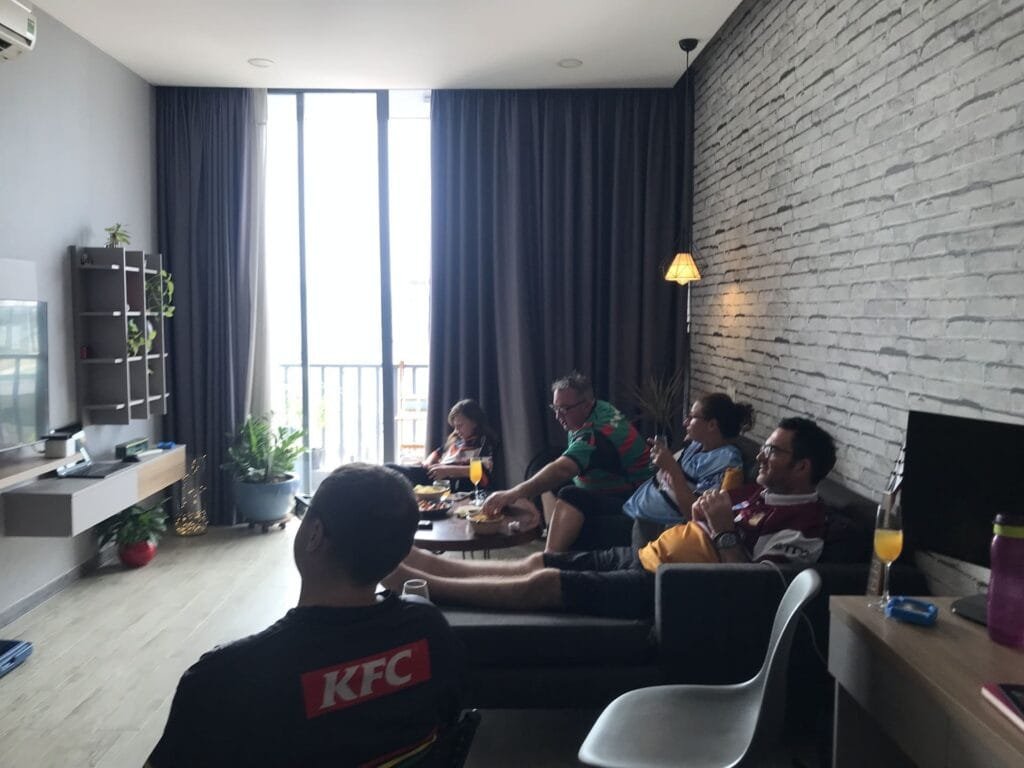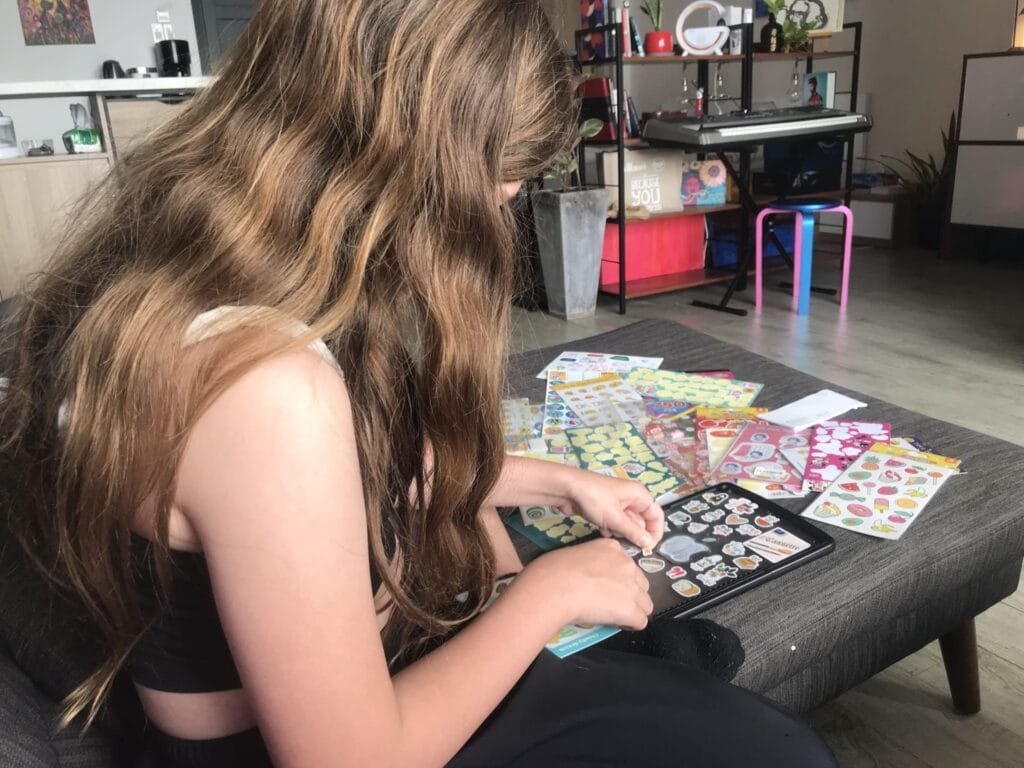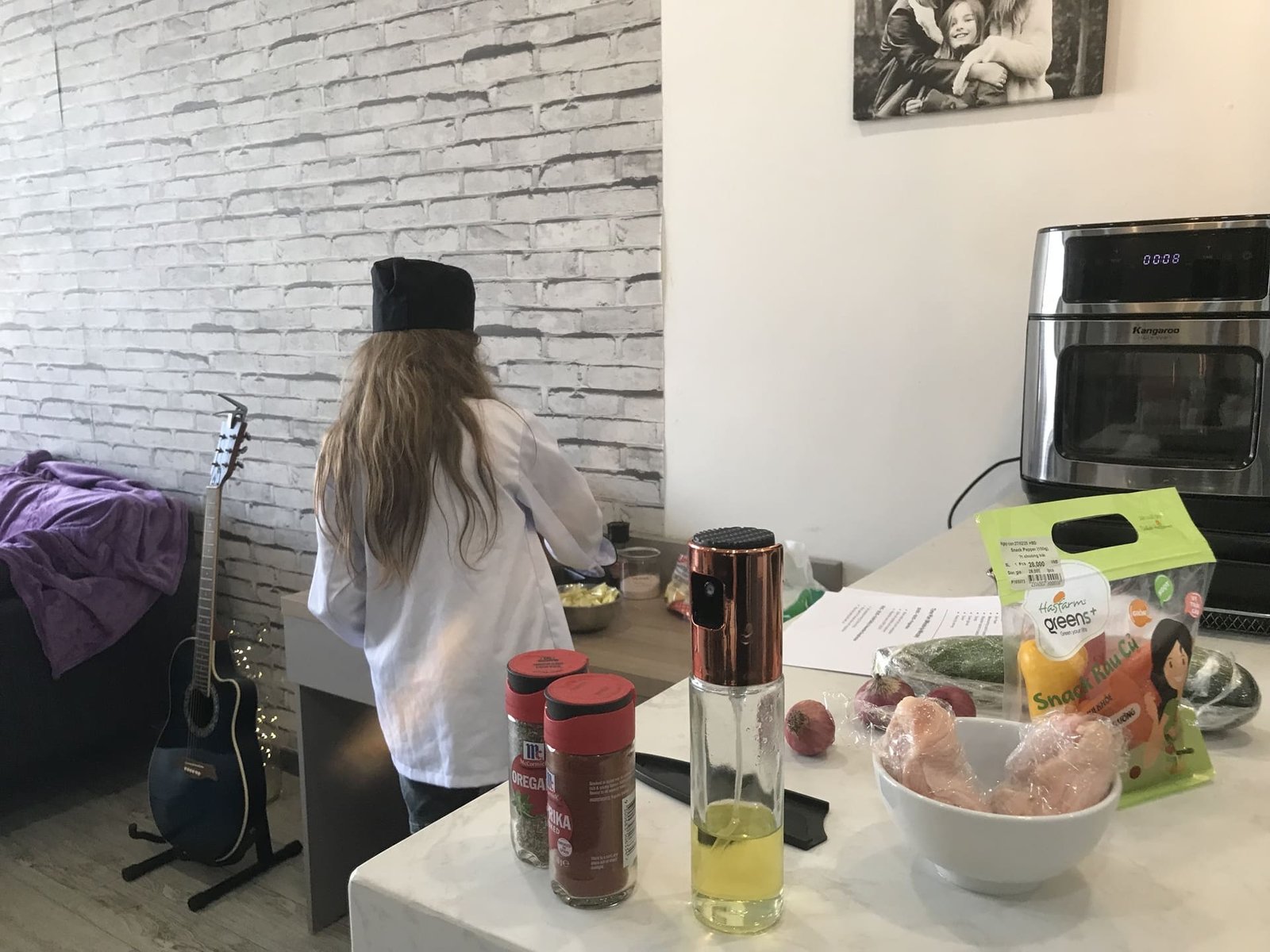After last week’s Audition Day, and the dramatic unfolding of events leading up to the invention of a new dish – Cheese-topped Bacon Tempura – I was grateful that the start of the NRL season gave Maxine and I an opportunity to spend time together, before we head back into the kitchen.

Last year, for the first time ever, the NRL headed to Las Vegas for the season opening games. Whereas the games played in Australia are shown between lunchtime and early evening in Vietnam, the Las Vegas season opener is an early morning breakfast affair. To celebrate this, I created a new tradition of hosting breakfast at my house – nicknamed The Hen House to ensure everyone knows they are entering Sydney Roosters territory.
It was pure coincidence that the 2025 NRL season started on the weekend after my first session with Maxine, and unlike last year, most of the crew had to work and wouldn’t join. This gave us plenty of time to chill and be comfortable together, before broaching the topic of our upcoming lesson.
Bacon Cheese Tempura
I was encouraged when Maxine bounced into the house at 7.15am, still looking very sleepy, but clearly excited for the day ahead. With a flourish, she pulls a food container out of her backpack: “Tada! Bacon Cheese Tempura!”. My worries that she might have become discouraged after the mandoline cut started to dissolve.
Because I hadn’t agreed to the Audition Rerun that she wanted, she had negotiated with her mother that, provided she finished her homework in time, she would be allowed a re-run of the dish she had invented to bring along to our rugby breakfast. Of course, Maxine being who she is, she had spent time going over the failures of our previous attempt. Not the injury she had sustained – she had moved on from that – but the fact that the bacon and cheese wouldn’t stick together for breadcrumbing.
Cleverly, after part-frying the bacon, she had decided to place the strips on an oven tray, sprinkle them with grated cheese and place the tray under the oven grill to melt the cheese. This kid is a natural born problem solver. She could teach my team a thing or two about the iterative process that makes Design Thinking as powerful as it is.

Our friend Martin reached for the container and fished out a slice. “They need to go into the air fryer to warm up before you eat them,” Maxine scolded him. “Hm, they look too good to wait,” he replied as he took a bite. “OMG, this is delicious!” he exclaimed, both their faces beaming with delight. As I warmed up the tempura in the air fryer, I was certain.
We were going to be just fine on Tuesday.
Knives in Primary Schools
The decision to move our sessions to mine felt so logical – the fresh environment would make it easier to keep Maxine focused and prevent her from slipping into bad habits that would be second nature in her own environment. And for my part, I would not be tempted to get comfortable in my friend’s home; at my place the singular focus would be on Maxine’s learning, safety, and the nice food we would (hopefully) create.
As I am visualizing the session the day before – a technique I learned when Leith’s forced us to make time plans, without which we wouldn’t be allowed to cook – in my mind, I go over the lesson plan, equipment, first aid kit (!), ingredients, recipes and imagine how the afternoon will unfold. Everything checks out until I get to knives. Doh. Knives. Primary School. Those two concepts don’t feel nice when they are close together.
When I was studying at Leith’s, travelling through Central London on the tube every morning and afternoon, we’d carry the knives in a closed wallet, with an accompanying letter explaining we were at Chef’s College. I have travelled around the world with this same set of knives – they are here in Saigon with me now, nearly 25 years later – and it is always an issue going through airport security, packing 10 or so lethal weapons. To this day, I will bring along my Leith’s Diplomas when my knives leave the house.
I explain the issue to Maxine’s parents – will she need a letter, can she leave the knives with security, should she just use my knives and get accustomed to two different sets? Her dad speaks with the principal, who wholeheartedly agrees that children shouldn’t bring knives to school, and the agreement is made that the knives will be kept in the principal’s office for me to collect when I pick Maxine up from school. Only after our session, when the three of us are having the dinner Maxine prepared, do I click that it would be much simpler for her parents to drop the knives off at my house on their way to school in the morning. Doh. Talk about overcomplicating a solution, Barbara.
Do you believe in God?
Of course, I love the idea of teaching a young person how to think and cook like a chef. But I am also finding out that I might enjoy the random conversations Maxine leads us into as we travel home from school even more. “Do you believe in God?”, she asks me by way of greeting as she runs down the school stairs towards me. “Hm, I don’t know,” I respond. “Well, do you have a religion?”, she insists. “I was born Catholic. I am not sure if I believe in God or not, but I am certain I don’t believe in organized religion any longer.” Uncertain what the distinction is, she ignores my response and gets to the point she has been trying to make. “There is no proof”, she states. “There is no God, because there is no proof.”
“Well,” I counter, “you know that the earth revolves around the sun, don’t you?” She looks up, makes eye contact and slightly squints. I can see her mind racing to figure out where this detour is leading, and how she can stay one step ahead of me. “Yeah, of course. And they used to think it was the other way around!” Both the disdain for those ancient folks – who must have been less intelligent than us – and the glee of believing she has trumped me are written all over her face.
“They did indeed, in fact, it was Ptolemy, way back in the 2nd century, who believed he had found proof for a geocentric system”, I tell her. “And here’s the thing, Ptolemy was able to calculate the motions of the stars and planets with enough accuracy, that the astronomical tables he created formed the basis of our understanding of the universe for nearly 15 centuries, before some other dudes, Copernicus, Kepler and Galileo, figured out the calculations would be more accurate when we put the sun at the center instead. So, having proof of something doesn’t mean it cannot be disproven when our understanding grows. And likewise, not having proof of something doesn’t mean that proof might not be found in the future.”
“Well, until then, I don’t believe in God.” Copy that, Maxine, let’s get cooking.
Chef’s School Setup
Before collecting Maxine from school, I had prepared my little studio to become a proper Chef’s School Setup. My desk is conveniently located right next to the breakfast bar, which of course is next to the kitchen. For Maxine’s sessions, the desk turns into her workstation, and the breakfast bar works perfectly as the mise-en-place area while she cooks, to then become “the pass” at service.
Maxine is always hungry when she comes home from school, which means a quick snack and a drink before she can concentrate on anything at all. Over a little bowl of pretzels and a Coke Zero, I take the opportunity to go through the upcoming lessons with her again. “Do you remember when we had our first chat about cooking together?” I ask her. She looks at me, waiting for me to continue. “Do you remember that I told you that you will be following a curriculum designed for adults?”.
“Yay!”, Maxine exclaims, throwing both her hands up in the air. It appeals to her that this isn’t Cooking for Kids – and it’s true, it really isn’t. Cooking for Kids is lots of fun – baking, pasta making, all the messy, hands-on, lick-the-pot stuff that kids love doing. I’m not trained to teach that. This is Junior Chef’s College, here we study cooking, we don’t play at cooking.
Week 1 Lesson Plan – Pommes Dauphinoise, Roast Chicken & Grilled Mediterranean Vegetables
Having set the stage that Chef’s College is serious business, I take Maxine through today’s lesson plan. Before anything else, first we go through Kitchen Safety & Etiquette – not because she cut herself the week before, but because that’s where every Chef’s College starts. My first day at Leith’s was pretty much identical, though I can’t remember the exact dish we cooked – it was 25 years ago!

Next up on Day 1 is Knife Skills. I picked the menu specifically around dishes that require a decent amount of slicing and dicing, while avoiding ingredients that are harder to chop safely. The potatoes for the Pommes Dauphinoise will teach her how to properly use her Chef’s Knife, using the whole of the blade and a rocking sort of motion. Doing this with 4 potatoes will also teach her patience and persistence 😉
As light relief, once she has completed this precision slicing task, she can take a bit of energy out on smashing cloves of garlics with the flat of the knife to peel them, to then do some cross-chopping. With all the ingredients prepped and measured, she sets about layering the potatoes. We talk about seasoning each layer – a little bit of salt and pepper, some garlic, a little bit of cheese – to ensure that the dish is flavorsome throughout, just seasoning the top won’t cut it.
Pommes Dauphinoise is not a difficult dish to prepare, but it does require a bit of patience to complete the simple, but repetitive tasks. I can tell Maxine is getting fidgety. For half of the potatoes she sliced, she stood at her workstation like a flamingo, but with one knee out to the side, as if making a 4 with her legs. Of course, this leads to potato slices that are thicker on one end than the other – something that surprised Maxine when I pointed it out to her. By the time she is layering the potatoes, she’s rocking from one leg to the other, unaccustomed to standing in one place for any length of time.
The Time Plan
Every session in the kitchen comes with its own Time Plan – as we are cooking multiple dishes, it doesn’t pay to stand around waiting for one thing to come out of the oven, before starting on another task. The purpose of the time plan, is to understand the order of all the recipes, identify efficiencies and time savings, ensure the hob and oven space required is available, and figure out how to keep your workstation clean throughout.
We’d gone through the plan in our little chat over pretzels, and as the potatoes go into the oven we review what’s up next. Maxine grabs the vegetables that need to be chopped for the grilled vegetables and skips over to the sofa and coffee table. “Uh, uh”, I tut, “Where do you think you’re going?”. “Oh, but I want to sit down”, Maxine complains. “Do you want to be a chef or do you want to be a home cook?”, I push her. Obediently, she walks back to her workstation to get back to work. She’s a little taken aback that cooking is actual hard work, though also seemingly a little proud that she’ll soon surpass the home cooks and become a real chef.
At this stage in the time plan, timings are becoming more crucial – after all, we want the potatoes, chicken and vegetables to all be ready at the same time. To keep things moving on the schedule, I guide Maxine more closely on the time she has available for each task, and what comes after, so we don’t need to stop to think. I also take on my fair share of cleaning as we go. I want her to serve the food on a clean pass and with an empty sink, just so she gets used to that being the standard.
Dinner is Served
Our timings end up working out perfectly, the chicken and potatoes come out of the oven 5minutes early, leaving the vegetables to finish cooking in the oven. This gives the meat juices a chance to settle, ensuring we have crispy skin, but tender meat.. The gratin benefits from a similar thing, leaving it to rest, or even cooking it the day before, allows the potato starch to settle and “glue” the layers of the gratin, making it easier to slice and serve.
Meanwhile, Maxine’s dad has arrived, and dinner is served. As she scoffs down her food, she recounts interesting tit-bits about each part of the meal, beaming with pride. Her dad scores her efforts a 9 out of 10, and I have to agree. This is good grub.
“What did you learn today then, Maxine, what was your biggest take-away?”, I ask her as I clear the plates. “A workstation!”, she exclaims, ” I can use a fold out table at my dad’s, and my mum has that big brown table that isn’t used. That will be my workstation!”
The Learnings
Maxine’s Learning Outcomes:
- Flamingos can’t slice straight.
- Flavour is built in layers.
- Cooks sit down to work. Chefs work at a workstation.
- Cooking professionally is actual hard work.
My Learning Outcomes:
- Kids say the funniest – though not un-profound – things.
- Cooking with kids means getting hands on if we want to serve food on time.
- It will be a while at least before Maxine will make her own time plan and do her own dishes.
Week 1 Recipes & Time Plan



Coming Up Next Week: Brownies & The Power Of Eggs



